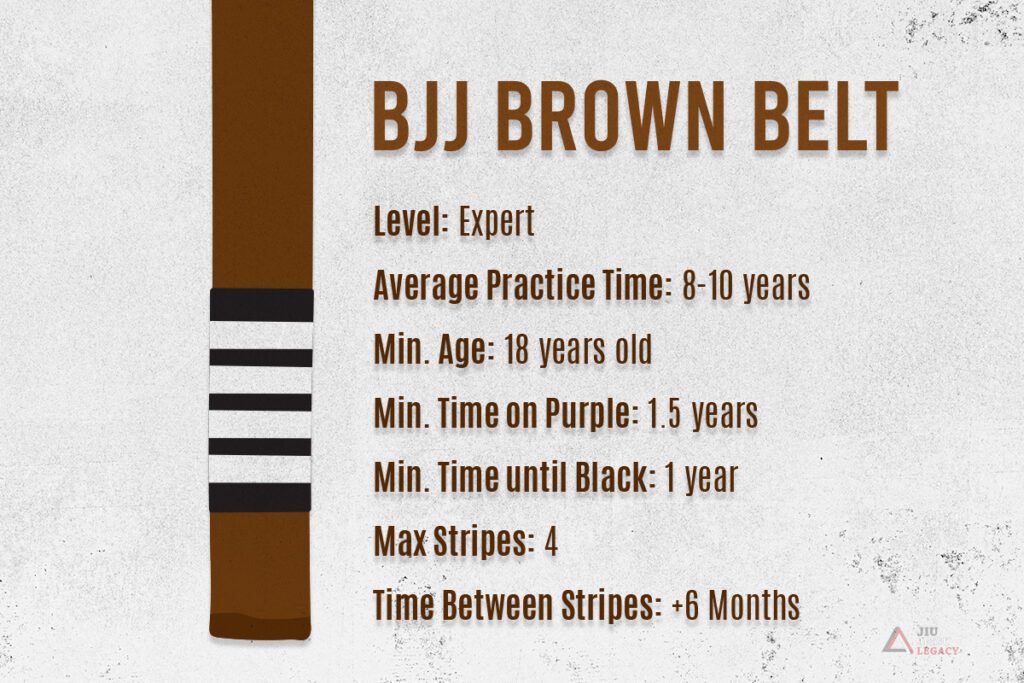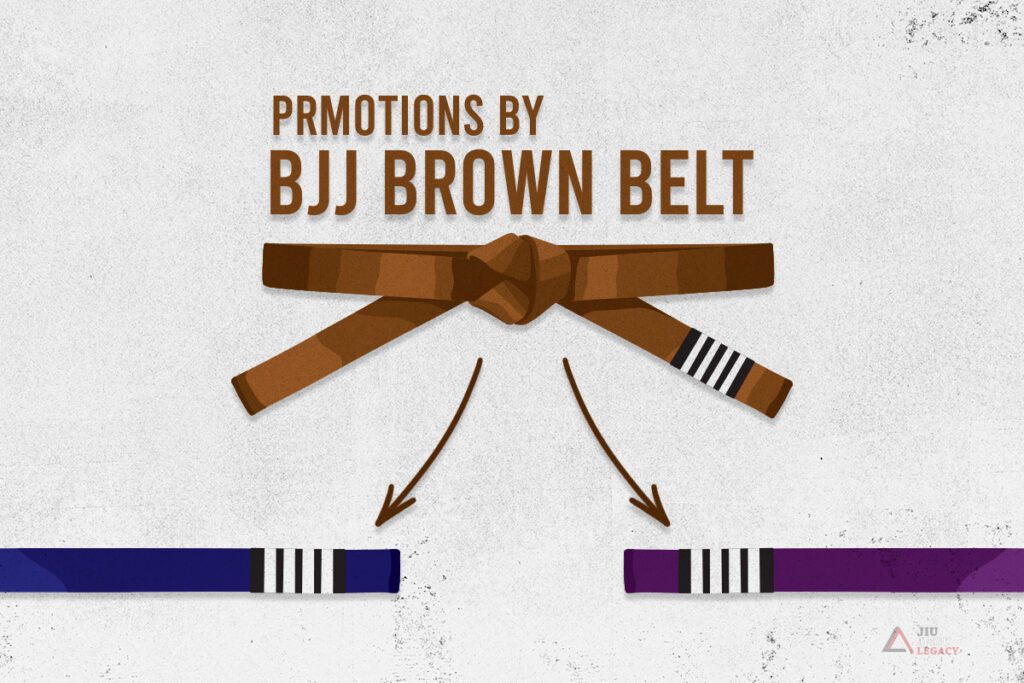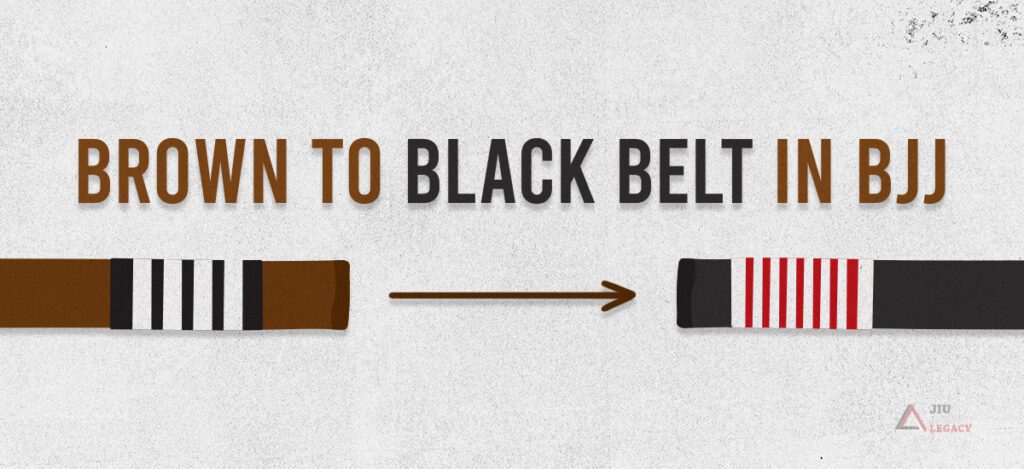If you are a Brazilian Jiu Jitsu practitioner, you probably know that the brown belt is among the most prestigious and challenging ranks to achieve in the art. It is the final belt in the Jiu Jitsu belt order before the coveted black belt, and it represents a high level of technical skill, practical experience, and conceptual understanding. But how do you get a brown belt in BJJ? What does it mean to be a brown belt?
Let’s explore.
How Many Years Does it Take to Get a BJJ Brown Belt?

The first question that many people ask when they start training BJJ is how long it takes to get a black belt. Consequently, there are similar time inquiries for all other belts, including the BJJ brown belt.
The answer is never simple, as many factors influence the BJJ belt timeline it takes to progress through the ranks:
- Frequency and intensity of training;
- The quality of your instructors and training partners
- The curriculum your academy implements;
- Your personal goals, motivation, and dedication;
- Your physical attributes, such as age, size, strength, flexibility, etc.
Given these variables, it is impossible to give an exact number of years it takes to get a brown belt in BJJ. However, based on general statistics and averages, we can estimate that it takes 8 to 10 years of consistent training to reach the brown belt level. According to the IBJJF, you must be at least 18 years old and have at least five years of BJJ experience to be eligible for a brown belt promotion. You must also spend at least 1.5 years as a purple belt before being promoted to brown.
Of course, these are just minimum requirements, and they do not guarantee you will get a brown belt after five years of training. Some people may take longer than that, and some freaks out there take significantly shorter.
What Does it Mean to be a Brown Belt in BJJ?
The next question that arises, and is a bit more complicated to answer concisely, is what does it mean to be a brown belt in BJJ? This is a mixture of individual priorities by the student, the coach’s standards and belt requirements, and the much more objective performance within the BJJ community.
In my opinion, a BJJ brown belt should display technical proficiency, understanding, positive attitude, and teaching involvement.
BJJ Brown Belt Requirements
The first thing to understand is that BJJ has no official or universal requirements for getting or being a brown belt. Brazilian Jiu Jitsu is not centralized as is, so every affiliation, academy, or black belt instructor gets to determine their own.
Some emphasize technical proficiency and knowledge, while others value competition results and performance. Some even employ formal tests and evaluations, which I find to be a waste of time and effort.
However, despite these variations, there are some common themes and elements that most instructors and practitioners agree on when it comes to the BJJ brown belt level.
For example, a brown belt needs to understand the fundamental principles and concepts of Jiu Jitsu, and not just techniques and moves.
It is back to basics at brown, and until I see a purple belt slowly re-ignite their interest in closed guard and abandon the flying belt-to-belt knot Musumeci-Ruotolo Cockroach guard or whatever is popular, they’re not ready for the purple to brown belt jump.
There is the tactical mindset as well, being able to understand strategy, recognize strong and weak areas in the game, understand timing, and ability to break down Jiu Jitsu into its smallest core components.
Behavior and Attitude
As one of the highest ranks in the art, a brown belt in BJJ should be a role model and a leader for the rest of the academy. They should embody the values and principles of BJJ, such as respect, humility, honesty, integrity, loyalty, etc.
Coaches or not, they should accept the responsibility that comes with experience and the rank they hold and maintain a positive and constructive mindset when discussing, teaching, training, rolling, or competing.
All the nonsense of mat enforcement and bully culture (unfortunately very prevalent in BJJ these days) should stop at brown belt. Let the purple belts think they’re gods, as you did yourself not long ago.
In short, a brown belt in BJJ should be a person of character and integrity who inspires and motivates others by their example.
And they need to know how to keep it playful.
Giving Back
A final aspect of being a brown belt in BJJ (in my humble opinion) is the responsibility of giving back to the sport and the community.
As one of the most senior members of the academy, a brown belt has a duty and privilege to share their experience and wisdom with others who may benefit from it.
Usually, brown belts focus on one of two main avenues: they are either avid competitors or start embracing teaching as their main role.
If you are a competitor, you should help in competition classes, work with students in developing their games, and guide lower belts in tournaments, both from their corner and as much-needed moral (and practical) support.
As an instructor, your task is pretty straightforward: you know enough BJJ to pass knowledge on to others and now need to master the fickle and everchanging (sounds familiar?) art of teaching.
There is no better way to give back than by teaching others how to become better than you.
Of course, these are not mandatory or exclusive activities for a brown belt. You can choose how you want to give back, depending on your interests, skills, availability, etc.
The main point is that you should recognize that you have something valuable to offer to the art and the community.
Can a Brown Belt Promote in BJJ?

The simple answer is yes, but only for adult belts below brown (i.e., blue and purple). They can promote kids throughout the full range of kids’ belt ranks.
According to the IBJJF rules, a brown belt can promote students up to the blue belt rank as long as they have at least two years of experience as a brown belt. However, they can only do so if they are affiliated with a black belt instructor who authorizes them to do so, and they also need to register themselves as a brown belt BJJ instructor with the IBJJF (not a money grab tactic at all).
Of course, this rule only applies to IBJJF-affiliated academies and tournaments. A brown belt can be promoted at will, given that sometimes brown is the highest rank in an academy.
There should be no fuss about this. As long as you got your brown belt from a legitimate black belt (verified by the community is my preference to having paid the IBJJF), you can promote as you see fit.
Just remember that promoting students is not a naive task, as they will reflect your Jiu Jitsu influence further.
How Dangerous is a BJJ Brown Belt?
It’s one of the dumber BJJ brown belt-related questions out there, but still one that’s often asked.
When it comes to the gym and practicing Jiu Jitsu, it’s essential to understand that your level of danger is only equivalent to that of a brown belt who truly comprehends the Gentle Art. This means acknowledging that there will always be individuals who are more skilled than you, including those with lower belt levels.
Those grapplers who understand this can genuinely be very dangerous, and this understanding usually dawns on people during their brown belt days.
On the streets, a BJJ brown belt should be able to take down, control, submit, or escape from any untrained opponent, regardless of their size, strength, or style.
In theory.
In a real-life scenario, it all comes down to character and lady luck (or her absence). We don’t practice BJJ for self-defense in a realistic manner, so people will still freeze up despite their experience when confronted with pure violence on the streets, and other parts of their attire might get a darker shade of brown than their belts.
Celebrities With BJJ Brown Belts
As BJJ became more and more mainstream, celebrities from different entertainment fields, such as music, movies, TV shows, etc., started showing up on the mats. Some of them, as rare as they are, even went as far as turning it into a passion, as proven by their achievement of the BJJ brown belt rank.
Some of these celebrities who can kick your butt include:
- Ashton Kutcher – That 70’s Show star actor is a brown belt under Rigan Machado.
- Jim Carrey – A Royce Gracie brown belt who trains very actively.
- Spencer Pratt – He got his brown belt from Ricardo “Franjinha” Miller. Trains inconsistently.
- Maynard James Keenan – Promoted to Brown by Luis Heredia in 2023, has been training since the 90s.
- Paul Walker – The late Fast & Furious star was a Ricardo Miller brown belt and very passionate about BJJ. After his death, he was granted a black belt.
Maynard James Keenan just recently made the jump from purple, and the stables are rich with celebrities at belt level, so we can expect a few more to join the elite sooner rather than later.
Brown to Black Belt in BJJ

The final leap. But to what?
The black belt is not only a symbol of technical skill and knowledge but also of personal character and maturity. It is a reward for hard work and effort, but comes with great responsibility.
And it will take you a decade (at least) to achieve it.
The jump from brown to black belt in BJJ, you need to accept that you’re becoming a white belt once again, but this time, you’ll have to keep that mentality.
Also, the period from brown to black will either be the shortest in your BJJ journey or the longest. There’s no faking it at this level, just truly making it, and unless you are black belt material, especially mentally, there’s no way forward.
Final Thoughts
Being a BJJ brown belt was one of the most fun periods in grappling for me. You get a taste of the black belt (almost) without all the responsibilities and the image that comes with it.
Brown belt is a time of fun, where your requirements are understanding the fundamentals of BJJ, learning how to be there for others, and starting to give back. It is a fun period where you can look back at the years of training you did and enjoy the ranks you share with some of the world’s celebrities.
Enjoy the ride!

Ogi is a black belt that does Jiu Jitsu full time and is very passionate about anything grappling-related.
He is also the head coach of Enso Jiu Jitsu in Macedonia and an aspiring Globetrotter.
